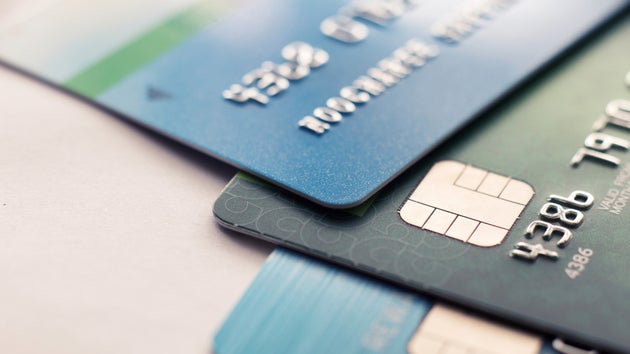Table of Contents
Credit card transaction process
Five players are involved in the credit card process. In addition to the cardholder and the merchant, the dealer bank (acquiring bank), the bank that issued the credit card (issuing bank) and the card company play a key role in the transaction process. In the first step, a customer submits his credit card to make a purchase. The merchant bank (acquiring bank) then contacts the bank of the cardholder (issuing bank) and checks its creditworthiness. This is done through the intermediary of a credit card company. Visa and Mastercard are among the largest companies on the European credit card market. These two credit cards payments are accepted almost everywhere in Europe. The credit card companies issue licenses to banks allowing them to issue credit cards. This is taken over by the banks. The credit card provider works so to speak as an intermediary and authorizes the card data. After the cardholder's creditworthiness has been checked, the issuing bank authorizes the transaction and forwards the response to the merchant. The issuing bank transfers the payment to the dealer bank and the money is credited to the merchant's account. The transaction has been completed.
For example, a customer has an account with the Sparkasse and has applied for his Mastercard credit card, with which he now wants to pay his train ticket to Italy. The bank of the train company, i.e. the dealer bank, now checks the data on the Mastercard credit card company and then checks and authorizes the customer's credit card data at the savings bank.
Processing fees
Credit cards are monetized through fees charged to customers and merchants. Most credit cards charge customers an annual fee. An interest rate is applied to purchases made, and additional fees are also added if minimal payment is not covered in time.
Processing fees for merchants can either be flat or transactional. They are made up of a base fee and assessments. Some procedures may incur further costs, known as incidental costs. For example, chargebacks imply an additional cost to merchants.
Discount fee
Also known as disagio, the discount fee makes credit card payments a worthwhile business for banks. This is a form of commission that is paid by the dealer bank (acquirer) to the bank of the cardholder (issuer). This means additional costs for the dealer. The level of disagio usually varies between 3 and 5 percent.
Base fee
These fees are determined by the issuer and the credit card company. Therefore, they are the same for all processors. They are also known as “wholesale” or “pre-markup”.
Interchange fee
Paid to issuing banks, the interchange fee is the biggest processing cost. Neither processor nor credit cards company make a profit from it.
The banks consider various variable including processing method (ex: POS, MOTO, e-commerce), card type (ex: business, consumer) and your business type (i.e. merchant category code), to create an exhausting list of interchange fees.
Interchange fees are assessed net of refunds and chargebacks. Usually, it consists of a percentage and a transaction fee. For example, 1.51% plus $0.10 is the current Visa interchange fee for a swiped consumer credit card.
Regulation EU
The Regulation on Interchange Fees for Card-based payment transactions (IFR) entered into force in June 2015. The regulation of the European Parliament and of the Council of the European Union addresses the widely varying and excessive hidden interchange fees which were an obstacle to the Single Market and a barrier to innovation. The Interchange Fees Regulation notably imposed a cap on interchange fees, 0,2% of the value of the transaction for consumer debit cards and 0,3 % for consumer credit cards.
Assessment fees
On every transaction, credit card brands charge assessments. While these do not vary from a processor to another, bundle prices might influence how they are being charged.
The type of fees and their price varies from one brand to another. The assessments for each card brand, as of January 2018, are listed below along with the details about when they apply.
Credit card markup fees
This is where processors make their living. However, it is not exclusively profit. Markups are split among all of the organizations that facilitate the processing of the transactions, such as, among others, the acquirer, processor, ISO(s), gateway or software provider. The markup must cover cost as well as profit for all of the parties involved.
As these fees vary from one company to another, it is recommended to compare providers. Here are some of the markup fees which may be applied:
Annual and monthly fees
Provider services may be charged in the form of annual or monthly fees. Some providers will charge neither.
Payment gateway fees
These fees pay for the software platform doing the technical processing the payment. It is usually either charged by transaction or monthly.
Alternatively, providers may set a minimum monthly or yearly sale value. Merchants who do not reach this value must pay a pre-set fee (fixed minimum fee, or basic fee). This way, the provider can insure that its costs are covered.
PCI compliance fee
PCI (also referred to as PCI-DSS) standards assures that the payment information is being used and stored safely. It is an obligation for service providers and merchants using credit card transactions to adhere to the PCI standard.
Online reporting and statement fees
Some providers charge a fee for producing statements. Merchants choosing to view their statements online might be charged an online reporting fee. The costs of printing and mailing physical statements, on the other hands, might be charged as statement fees.
Credit card terminal fees
Point of sale terminals can either be bought or rented. The purchase of hardware and software can, depending on the number of POS systems, quickly amount to several thousand euros. Rental models make sense because of the low investment, especially for small businesses or short-term use of mobile terminals.
Early termination fee
Merchants contract with payment providers usually have a include a penalty in case the services are cancelled earlier.
Advantages of credit card for merchants
- Approx. 20 percent of Germans own a credit card
- Approx. 35 million cards are in circulation in Germany
- Customers with credit cards usually have a higher budget
- High security standards (e.g., 3D Secure)
- The ability to pay with many credit cards is crucial for the conversion rate
- Global payment method
Disadvantages for traders
- Relatively high processing fees
- Risk of a chargeback
Nowadays, few people leave the house without a credit card. But what advantages and disadvantages does the credit card have for the customer?
Benefits of credit card to customers
- Granting of a short-term loan (until the end of the month)
- Accepted in more than 200 countries
- Can usually be used free of charge when traveling
- One of the safest payment methods for online purchase worldwide
- Many different insurance services offered (e.g., insurance against theft)
- Many online shops accept the credit card as a means of payment
- Reduction of the risk of loss of cash
Disadvantages for customers
- Because the credit card company charges transaction fees to merchants, smaller online shops might choose not to accept credit cards
- Partially higher fees
- Risk of interest payment, if the invoice is not paid in time
Payment processing companies
There are two types of processors, often called payment gateways or payment distributors, front-end or back-end processors. Front-end processors route transactions from merchants to the cardholder's bank to gain authorization. Back-end processors take settlement, depositing the funds in the merchant’s account.
Merchants use these to process credit card payments as well as other payments, for example bank transfers, invoices, direct debits. In e-commerce, the payment gateway offers numerous advantages for payment processing. With continuous availability 24 hours a day, card payments or alternative payment methods can be authorized at any time of the day and efficient processing can be ensured.
Processors: Stripe, Square, Worldpay
The software platform Stripe offers a commission-based solution, with a straightforward card processing service. Its key features include one-click payment, and their signature youthful checkout design. Integration is kept as easy as possible, stating that merchants can start accepting payments 10 minutes after signing up.
Square is well-suited for small businesses, charging no monthly fees for businesses processing less than 250 000 USD. Their tiny Square Reader devices, a key feature, allows merchants to accept payments in person.
The international online payment gateway Worldpay, based in the UK, provides several payment services for online, in-store and omnichannel businesses. Key features notably include fraud screening, recurring payment subscriptions and reporting tools.
Credit card safety procedures
On the one hand, traders take advantage of the low fees. On the other hand, the increased safety regulations have a negative impact on user-friendliness. Since November 2015, "two-factor authorization" has been the new standard for online transactions. Customers who want a higher security standard can use 3D Secure method (e.g. Verified by Visa or Mastercard SecureCode). The buyer must enter his credit card number. The card issuer is then contacted and the buyer can confirm his identity using a code. If the authentication is successfully completed, the credit card payment is carried out. More than 70 percent of dealers use the 3D Secure method. As mentioned, the new safety precautions also has some down sides. Most retailers (61%) observed an increase in the disruption of payments with the 3D Secure method. From January 2018, two-factor authentication will also affect other means of payment. It remains to be seen what impact this has on the use of credit cards.










